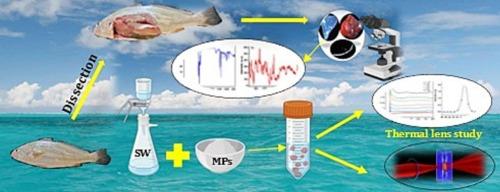Threat to thermohaline circulation via rising thermal diffusivity in microplastic-contaminated seawater – a dual-beam thermal lens study
IF 7.2
1区 地球科学
Q1 GEOSCIENCES, MULTIDISCIPLINARY
引用次数: 0
Abstract
The present study investigates the modifications in the thermal behaviour of sea water (SW) by microplastics (MPs) using the mode-mismatched dual-beam thermal lens (MDBTL) technique, as the uncontrolled use of plastics has led to MP contamination, posing risks to marine ecosystems and potentially disrupting thermohaline circulation by altering seawater temperature and salinity balances. The abundance of MPs in SW is revealed through their presence in the gastrointestinal tracts of fish, which are identified as polypropylene by Fourier transform infrared and Raman spectroscopy. Though the increase of salinity is found to lower the thermal diffusivity (D) of water, the increase of MPs is found to enhance the D value of SW. The study emulating MP contamination in SW revealed a D value enhancement of 30.71 % for 10 ppm of MPs. The increase in D implies faster thermal transport in seawater, which can disrupt the thermohaline circulation, a crucial component of global ocean circulation driven by temperature and salinity gradients. Dynamic light scattering analysis showed that at 10 ppm, MPs had a zeta potential of −15.54 mV and particle size of 1.952 µm, indicating moderate electrostatic stability; at 0.1 ppm, 50 nm particles with +1.19 mV zeta potential aggregated rapidly due to ion screening. The UV–visible spectroscopic study also points to the increase of UV absorption due to the rising amount of MPs, resulting in temperature rise. The rising D value of SW can seriously affect the marine ecosystem and the thermohaline circulation, transforming the local phenomenon into a global one, revealing the significance of the work.

微塑料污染海水中热扩散率上升对热盐环流的威胁——双光束热透镜研究
本研究使用模式不匹配双光束热透镜(MDBTL)技术研究了微塑料(MPs)对海水热行为的改变,因为塑料的不受控制的使用导致了微塑料污染,对海洋生态系统构成了风险,并可能通过改变海水温度和盐度平衡来破坏热盐循环。通过鱼类胃肠道中MPs的存在,揭示了SW中MPs的丰度,通过傅里叶变换红外和拉曼光谱鉴定为聚丙烯。盐度的增加降低了水的热扩散系数(D),而MPs的增加则提高了水的热扩散系数(D)。在SW中模拟MP污染的研究表明,MP浓度为10 ppm时,D值增加30.71%。D的增加意味着海水中更快的热输送,这可能会破坏热盐环流,而热盐环流是由温度和盐度梯度驱动的全球海洋环流的关键组成部分。动态光散射分析表明,在10 ppm时,MPs的zeta电位为−15.54 mV,粒径为1.952µm,具有中等的静电稳定性;在0.1 ppm下,具有+1.19 mV zeta电位的50 nm粒子由于离子筛选而迅速聚集。紫外可见光谱研究也指出,由于MPs量的增加,紫外吸收增加,导致温度升高。SW的D值上升会严重影响海洋生态系统和温盐环流,将局地现象转变为全球性现象,揭示了工作的意义。
本文章由计算机程序翻译,如有差异,请以英文原文为准。
求助全文
约1分钟内获得全文
求助全文
来源期刊

Gondwana Research
地学-地球科学综合
CiteScore
12.90
自引率
6.60%
发文量
298
审稿时长
65 days
期刊介绍:
Gondwana Research (GR) is an International Journal aimed to promote high quality research publications on all topics related to solid Earth, particularly with reference to the origin and evolution of continents, continental assemblies and their resources. GR is an "all earth science" journal with no restrictions on geological time, terrane or theme and covers a wide spectrum of topics in geosciences such as geology, geomorphology, palaeontology, structure, petrology, geochemistry, stable isotopes, geochronology, economic geology, exploration geology, engineering geology, geophysics, and environmental geology among other themes, and provides an appropriate forum to integrate studies from different disciplines and different terrains. In addition to regular articles and thematic issues, the journal invites high profile state-of-the-art reviews on thrust area topics for its column, ''GR FOCUS''. Focus articles include short biographies and photographs of the authors. Short articles (within ten printed pages) for rapid publication reporting important discoveries or innovative models of global interest will be considered under the category ''GR LETTERS''.
 求助内容:
求助内容: 应助结果提醒方式:
应助结果提醒方式:


